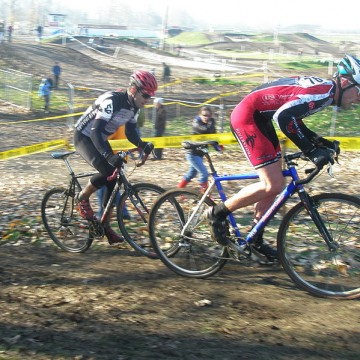Mud, Sweat and Tears: Cyclocross Demystified
Saturday, October 11, 2014

They have colorful matching suits and sleek booties pulled over their cycling shoes. And when they leave the café they don’t just get on their bikes and ride off into the freezing rain. They push their bikes and run a few paces down the street before jumping onto their saddles with the grace of a prima ballerina.
They are cyclocross racers, and if you’re serious about cycling in Portland, you like beer and bonfires, and you think getting muddy outdoors is a good use of time, you must become one.
From September to February cyclocross races abound every weekend across the Pacific Northwest, but for die-hard fans of the sport cyclocross—or more commonly, just ‘cross—racing gets better the worse the conditions.
Portland is renowned among cyclocross-crazed areas around the country for how accessible local promoters have made the sport. There are large beginner fields at nearly every local event and dozens of free or low-cost clinics where newbies can receive expert guidance in the basic techniques of the sport, which differ from those of other forms of bike racing.
Beginner Doesn’t Mean Easy
Originating in Europe in the early 1900s, the sport consisted of racers competing in unsanctioned, off-season, steeplechases from town to town, over rough, unpaved roads. Racers were permitted to dash through farmers’ fields, scramble over fences, or take any other shortcuts that would help them finish first.
Today’s cyclocross is both more structured and organized, while also wildly unpredictable.
Races consist of many laps on a short course comprised of paved surfaces, dirt trails, grassy fields, steep hills or even staircases, and obstacles—or barriers—requiring the rider to dismount, shoulder and run with their bike through the obstacle before remounting.
Professional category races last about an hour, while beginner races clock in at around 30 minutes. But mind you—these are 30 pain-filled, all-out aerobic minutes. And while the running sections aren’t long, they to do require skill to dismount and remount the bike without losing time.
What You Need to Get Started
Cyclocross bicycles are similar to road-racing bicycles in that they are lightweight, utilize the same wheel size for efficiency, and sport narrow tires and drop handlebars. The key differences between road and ‘cross bikes are lower gearing for pedaling through greater rolling resistance, stronger frames, cantilever or disc brakes and a more upright riding position.
They are designed with higher tire clearance to use tires with tread and still be able to shed mud and debris accumulated from the course.
An old, hard-tail mountain bike will work if you just want to jump in and give it a try, but a cyclocross bike will be lighter, faster, more comfortable, and easier to carry when portaging your bike over obstacles or hills that are too steep and muddy to ride. Disc brake enabled cyclocross bikes also make great winter commuters, as the disc brakes provide cleaner, superior stopping power as opposed to run brakes; just throw removable fenders on for street riding and pop them off before your race.
Cyclocross as Spectacular Spectating
Watching a professional level cyclocross race is impressive. Not only are the pros fast when they’re riding their bikes, they are also incredibly smooth dismounting their bikes, running without missing a beat through low barricades, then gently setting their bike down and seemingly floating back onto the saddle—all without losing speed.
It’s those transitions between riding and carrying/running where races are won or lost; the smoother one’s technique, the faster the race result. If you’ve ever taking a stroll on Leif Erickson on a wet fall day you’ve likely seen ambitious cyclocrossers practicing their dismounts and remounts. Though not a difficult skill to acquire, it takes a great deal of practice to smooth it out.
And while practice may make perfect, it also makes for plenty of low-speed crashes and falls. It’s part of the joy of the sport, at least for spectators. A cyclocross race serves up a carnival atmosphere, and fans are almost as animated as the racers.
Nearly everyone comes prepared with a cowbell to make noise, shouting encouragement at (and heckling) the racers through often wretched conditions. Wet, cold, muddy—both fans and riders embrace the elements as part of the “glory of suffering” inherent in the sport.
In fact, some say the worse the weather, the better the ride.
Many teams bring pop-up tents to shelter them during a warmup before races. Many riders also stay for part of the day to encourage teammates and other racers. Some bring warm drinks, food, or small fires in portable fire pits, which they are happy to share with Gore-Tex clad spectators who wander the course looking for the best viewing spots.
True to Pacific Northwest style, craft beer flows freely, with most teams and races sponsored by local breweries. While the competition can be serious, the overall spirit of the sport is friendly, fun and effervescent—a perfect way to beat those dull gray winter blues with a bit of mud, sweat, and tears.
Want to learn more? Check out the Oregon Bicycle Racing Association’s event listings for dates of cyclocross clinics and races.

Üma on her bike
Related Articles
- Dying to be Seen: Invisible Is Not a Super Power for Cyclists
- Eat Well, Heal Fast: A Guide to Nutrition for Bikers
- On Your Bike: How To Choose The Right Ride
- Portland’s Bike Plan Makes Biking Safer in the City
- Bike Culture SOS: Save Our Shops




 Delivered Free Every
Delivered Free Every
Follow us on Pinterest Google + Facebook Twitter See It Read It